
We recommend that you also enter your university email address this would make your profile eligible for inclusion in Google Scholar search results. Once you've signed in to your Google account, open the Scholar profile sign up form, confirm the spelling of your name, enter your affiliation, interests, etc.That you can keep your profile for as long as you wish. We recommend that you use a personal account, not an account at your institution, so First, sign in to your Google account, or create one if you don't yet have one.Note: if you do not see your amended style in the list you may need to check that your style folder is set to locate your personal file space (H drive). We have attached an example of this called ' Word_count_style.ens', which you can use, simply download and save to the EndNote Styles folder in your H drive. You then need to find your newly created blank referencing style, and choose this newly created output style in EndNote, then also in Microsoft Word (see attached FAQ for how to find new styles).Īs it is a blank style it will remove all citations so that you can then do your word count: If the new style does not automatically save to your H: drive then you will need to find it in your documents/downloads and move to your styles folder in your H: drive. Then save it in your EndNote styles folder in your H drive, (if you do not have a Styles folder in your EndNote folder on your H drive, we recommend you create one in order to keep all of your EndNote materials together). In the New Style window select File>Save as and give the blank style a name, e.g. To give the illusion of removing all of your in-text citation and bibliography references from your essay, so that you can obtain a word count without them, you need to create a blank EndNote Output style. In EndNote select Tools>Output styles>New style:


If you wish to exclude your EndNote citations from your word count, you can do this by creating a new style that hides all citations.


 0 kommentar(er)
0 kommentar(er)
